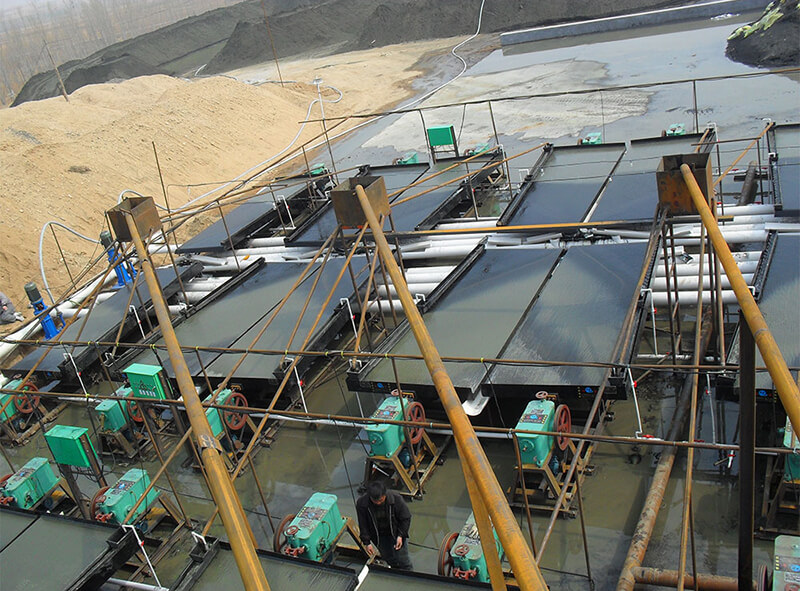In what way does a gold mining shaker table work?
Gold mining shaker table is a kind of gravity separation equipment that uses the combined action of mechanical shaking and water washing to separate ore particles according to density. Because of its high rich ore ratio, it can obtain qualified concentrates and final tailings at one time. It is widely used in the heavy selection of various minerals. So, if we want to get a good reselection effect, what operating points should we pay attention to during the operation of the shaking table?
1. Maintain appropriate stroke and stroke times
The suitable values of shaker stroke and stroke times are mainly related to the particle size of selected materials, followed by shaking table load and ore density.
When dealing with materials with large particle size and thick bed, it is necessary to use large stroke and small punching times, while when dealing with fine sand and slime, it is just the opposite, small stroke and large punching times should be used. When the load on the bed surface increases or the materials with high density are selected, a larger stroke and stroke should be adopted.
During production, the stroke of the shaker is generally in the range of 5-25mm, and the stroke times are in the range of 250-400r / min.
2. Adopt a suitable lateral slope of the bed surface
The lateral slope is large, the lateral water velocity increases and the ore particle sliding effect is enhanced, thereby increasing the tailings discharge speed, but the zoning of the beneficiation area will be narrowed accordingly, which is not conducive to improving the quality of the concentrate, so the bed The lateral slope of the surface is not as big as possible.
Generally, when handling coarse-grained materials, the lateral slope of the shaker is relatively large, and when handling fine-grained materials and sludge, the lateral slope is relatively small. During the production process, the adjustment ranges of the cross-slope angle of the coarse sand, fine sand and shale gold mining shaker table are 2.5°-4.5°, 1.5°-3.5° and 1°-2°, respectively.
3. Ensure that the flushing water is evenly distributed and the size is appropriate
Shaker flushing water mainly includes two parts: feed water and washing water, which together with the above-mentioned lateral slope determine the velocity of the lateral water flow. When processing the same material, both “big slope and small water” and “small slope and big water” can make the ore particles obtain the same lateral velocity, but “big slope and small water” is more helpful to save water, but it will change the concentrate belt. narrow.
Therefore, the flushing water should be evenly distributed on the bed surface and the size should be appropriate. When performing rough selection and sweeping operations, use “big slope and small water”, and use “small slope and big water” for selection.
4. Keep the amount of ore supply appropriate and even
The amount of ore fed from the shaking table is related to the selected particle size. The coarser the particle size, the larger the amount of ore fed. For specific materials, the amount of ore feed should be controlled within the allowable range of large bed surface utilization, obvious zoning, and tailings grade. Excessively large amounts will result in a significant decrease in the recovery rate. In addition, once the amount of ore is accurately identified, it must be maintained continuously and evenly, otherwise the zoning will be unstable and the sorting index will fluctuate.
5. Maintain the proper ore concentration
For shaking table beneficiation, the proper concentration of ore feed can ensure that the slurry has sufficient fluidity and stratification along the bed surface, and the water is deeply immersed in the ore particles, generally in the range of 15-30%. When dealing with coarse sand, the ore concentration is mostly 20-30%; when dealing with fine sand, the ore concentration is mostly 15-25%.
6. Make preparations for the selection of materials
In order to facilitate the selection of the appropriate operating conditions of the shaking table, the ore needs to be classified before being selected. A 4-6 chamber mechanical stirring hydraulic classifier is often used to classify the ore on the gold mining shaker table.
In addition, the upper limit of the selected particle size of the shaker is 2-3mm (coarse sand shaking table), and the lower limit of the recovery particle size is 0.02mm (mineral mud). Increase and decrease the stratification speed, resulting in the loss of heavy minerals. Therefore, when the sludge content (less than 10-20um particle size) in the shaker feed is high, pre-desludging is required.
7. Observation of materials on the bed surface and product take-up
Under suitable operating conditions, the materials are obviously separated on the gold mining shaker table, and the products are picked up according to the required sorting index. Generally, they can be divided into 2-4 kinds of products (China Mining generally needs to be reprocessed). However, when the operating conditions change, the zoning situation of the shaking table will change accordingly. The shaking table operator must closely monitor the zoning situation and adjust the product access position accordingly to ensure the normal operation of the shaker.
We can provide you with more information about the shaking table. If you have any questions, please contact:
Whatsapp:+86 133 1927 7356
Email:[email protected]





